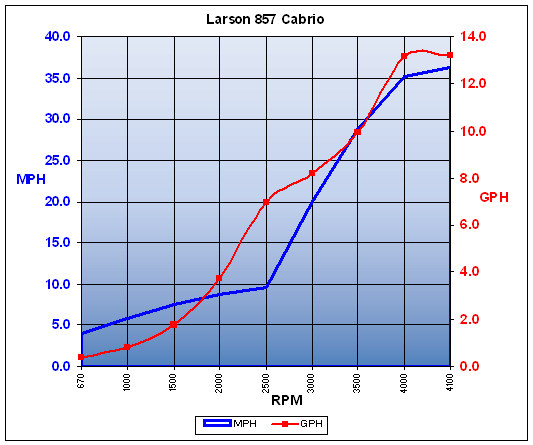Brief Summary
With a weight of only 694 lbs (315 kg) Yanmar continues to push the power to weight boundaries even further. The 6BY2-260Z was built to take advantage of increased fuel economy with common rail injection, and to take advantage of Yanmar’s new line of sterndrives. Adding intercooling and turbo charging helped to not only meet the stringent demands of the customers, but also the new EPA regulations. When paired with Yanmar’s hydraulic sterndrives, the combination is impressive.
Key Features
- Alternator 12-V - 150A single pole
- Protection cover for engine transmission
- High riser mixing elbow
- Flexible mounts
- Glow plug controller and related parts
- Electronic control head
- LCD display
Specifications
| Type of Engine | |
|---|---|
| Number of Cylinders | 4 |
| Horse Power | 260 |
| Configuration | Inline 4 |
| Weight | 694.00lbs |
| Fuel Type | Diesel |
| Fuel Delivery | Fuel Injected |
| Shaft Length Options | |
| Shift Throttle Control | |
| Displacement | 183.00cu in |
| Steering Control | |
| Recommended Fuel | |
| Alternator Output | 12 V - 150 A |
| CARB Rating | |
| Engine Monitoring System |
Captain's Report
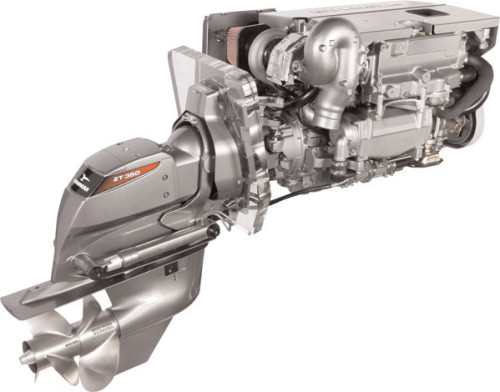 The 6BY2 has a weight of 745 lb (338 kg), and measures 39.4” (1000 mm) L x 30” (761 mm) W x 28.4” (721 mm) H. This is a compact envelope.
The 6BY2 has a weight of 745 lb (338 kg), and measures 39.4” (1000 mm) L x 30” (761 mm) W x 28.4” (721 mm) H. This is a compact envelope. Breaking-In
When you purchase a new Yanmar diesel, as with any other engine, there is a break-in process that should be adhered to. In the case of the 6BY2-260Z that process generally takes effect in the first 50 hrs. You’ll want to operate your engine with as much of a load as possible. This is typical of diesel engines, they love to work. Idling is something that should be avoided, particularly in the break-in period. You’ll also want to pay close attention to your temperature and oil pressure, and daily checks, and perhaps make them twice-a-day checks.
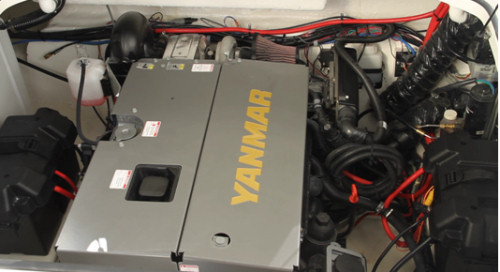 The installation in our test boat left plenty of room on all sides for ancillary items such as a hot water heater, water tank and even a generator.
The installation in our test boat left plenty of room on all sides for ancillary items such as a hot water heater, water tank and even a generator. Green Up
Yanmar is an environmentally friendly company and as such they’re approving the 6BY2 diesel engines for use with bio-diesel, but only if that fuel complies with ASTM D-6751 standards. These bio-diesel fuels are known in the marketplace as B5 bio-diesel fuels. B5 bio-diesel fuel can reduce particulate matter and the emission of “greenhouse” gases compared with standard diesel fuel.
Use caution however. If the B5 bio-diesel fuel used does not meet the approved specifications, it will cause abnormal wear of injectors, reduce the life of the engine and it may affect the warranty coverage of your engine. This cautionary advice is applicable to any engine, not just Yanmar diesels.
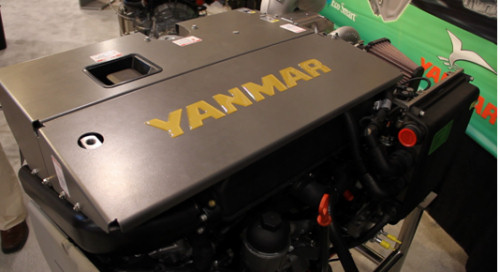 One major change in this next generation design was the plastic engine cover -- which was subject to easy damage from every mechanic that laid across the top of the engine -- so it has been replaced with this aluminum version.
One major change in this next generation design was the plastic engine cover -- which was subject to easy damage from every mechanic that laid across the top of the engine -- so it has been replaced with this aluminum version. Bleeding the Engine
One of the features of diesel engines, if not the bane of their existence, is their dislike for air in the fuel. Whenever one is serviced in such a manner as to require opening a fuel line, then the system needs to be “bled” or purged of any air bubbles. Generally this is a painstaking process of cracking a line at the fuel pump and manually pumping fuel through the system until it runs clear and free of bubbles.
This is not the case with Yanmar’s 6BY2 series of engines. They’ve managed to incorporate a bleeding procedure that requires no tools and does not leave you smelling of diesel fuel for the rest of the day (not that there’s anything wrong with that). Yanmar fuel pumps are ECU-controlled and will operate for only 10 seconds when the key switch is turned ON while the engine is not running or being started. For this reason, to sufficiently bleed the fuel system the key switch is repeatedly turned ON then OFF in the following manner.
1. Turn the key switch on (NOT start) and leave on for 10 seconds.
2. Turn key switch OFF for 5 seconds, then turn key switch ON for 10 seconds.
3. Repeat steps 1 and 2 five more times.
Repeat as necessary. Speaking as a person who has bled more than his share of fuel lines, this is a huge benefit, and one that any mechanic will be happy to take part in.
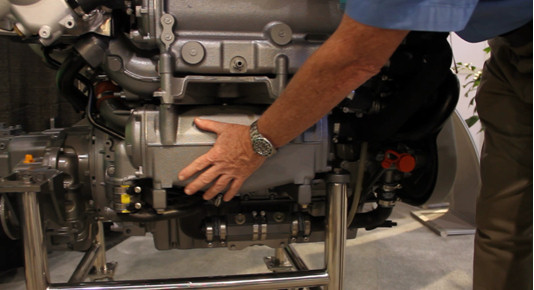 The turbocharger pressurizes the air coming into the engine. It is powered by a turbine that is driven by exhaust gases. The transmission oil cooler is just beneath.
The turbocharger pressurizes the air coming into the engine. It is powered by a turbine that is driven by exhaust gases. The transmission oil cooler is just beneath. It’s All about Yanmar
One important aspect of our test was that it was all about Yanmar. From the engine, to the outdrive, to the engine controls, to the gauges. So what does this mean to you? Well for starters, when one company builds every component, then that one company is responsible for all those components and there is no finger pointing when/if something should fail. Having one service center for everything on your drive system is a very attractive feature.
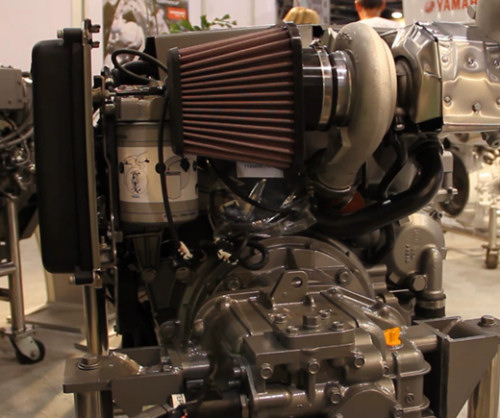 Just behind the air filter is the fuel fine filter. It filters out microscopic particles that make it past the primary filter which is externally mounted in your boat. To the left is a square box called the “E-Box.” It houses the engine electrical system fuses, relays, and ECU. The ECU monitors data from the various sensors and controls such functions as low-pressure fuel pump operation, fuel injection pressure, fuel injection system volume, and the timing and volume of fuel injected by the electronic fuel injectors. The ECU also uses sensor inputs to monitor engine condition and will set a trouble code if a system or sensor indicates a problem.
Just behind the air filter is the fuel fine filter. It filters out microscopic particles that make it past the primary filter which is externally mounted in your boat. To the left is a square box called the “E-Box.” It houses the engine electrical system fuses, relays, and ECU. The ECU monitors data from the various sensors and controls such functions as low-pressure fuel pump operation, fuel injection pressure, fuel injection system volume, and the timing and volume of fuel injected by the electronic fuel injectors. The ECU also uses sensor inputs to monitor engine condition and will set a trouble code if a system or sensor indicates a problem. Outdriven
In our test case, not only was the engine Yanmar, but the new outdrive was also a recent Yanmar release. This was the ZT350 dual prop outdrive. One important feature to note about this particular outdrive is that it is hydraulically actuated. That means two things: First, the cone clutch, which has been popular since the introduction of the sterndrive in the late 50s, has been replaced with a hydraulic clutch (like that used in a marine transmission). Second, that annoying “clunk” as you drop the drive in gear, and that even more annoying “gear grinding” sound as you ease the lever into gear, are both gone as well. Now, you move the control and the drive engages in a whisper smooth fashion and off you go.
Control Freaks
Yanmar has also stepped up and given their customers digital controllability. Since the 6BY2 is electronically controlled, it makes sense to add a digital control station to ease your operation. The benefits of this type of control station are two-fold. First, there are no more cable runs from the control to the engine. Now it’s a simple wire run and the control station is plug-and-play. This also means that adding control stations, as in the case of a tuna tower or cockpit control station, is as simple as adding another wire run. Additionally, now you are able to add a whole host of features to those controls, such as engine sync, throttle only, single lever, and individual drive trim controls.
And since we have now refined how we talk to the engines, we can also make it easier for the engines to talk back to us with improved programmable gauges. Now we can select from a series of displays to give us data on fuel consumption, mpg, temps and pressure among others.
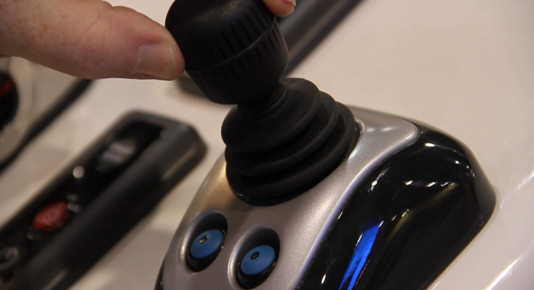 With electronically controlled engines, it’s easy to dictate what controls are capable of. In this instance, a sterndrive joystick is shown.
With electronically controlled engines, it’s easy to dictate what controls are capable of. In this instance, a sterndrive joystick is shown. 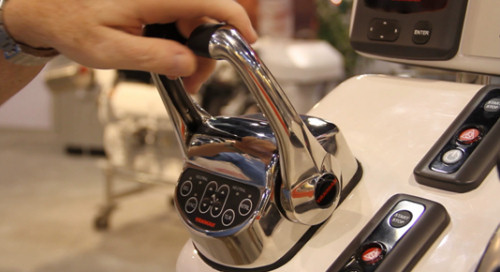 Digital controls will provide the capability of synchronizing the engines with the touch of a button. Also single lever control, cruise mode and individual trim adjustments are possible.
Digital controls will provide the capability of synchronizing the engines with the touch of a button. Also single lever control, cruise mode and individual trim adjustments are possible. Performance Evaluation
We set out to test the Yanmar 6BY2-260Z in a typical application. As such, we located a weekender with a test weight of just under 8,200 lbs. (3,719 kg). Our top speed came in at 4100 rpm and 36.4 mph. At that speed we had a fuel burn of 13.2 gph and were getting 2.76 mpg.
Best cruise was reached at 3500 rpm and 28.8 mph and 2.89 mpg. The really good news is the fuel burn of 10 gph. This makes an ideal number for estimating how much time you have on your remaining fuel. For example, our test boat had a fuel capacity of 84 gallons. At 10 gph it’s easy to see that we can run at cruise speed for 8.4 hours (remember -- 1 gallon per 6 minutes). Half a tank will last you 4.2 hrs…etc.
Hold the Whiplash
Now being a diesel, our 6BY2 had a slow acceleration curve, as compared to a typical gasoline engine. We view this as an acceptable tradeoff for the improved fuel economy of diesel engines. As the turbo charger doesn’t kick in until reaching roughly 2500 rpm, we reached planing speed in 9.9 seconds, 20 mph in 6.2 seconds and accelerated through 30 mph in 22.8 seconds. Not necessarily fast times, but as we aren’t running a race in this type of boat, it’s not bad either.
Yanmar’s second generation diesel engines are improved in every way over the counterparts they are replacing. They burn cleaner, are lighter, have more robust components and an improved power to weight ratio. Combining with Yanmar outdrives and controls make a marriage made in heaven… at least ease of maintenance and operation heaven.


